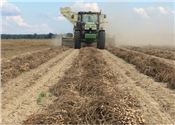Despite Disease Pressure, Peanut Crop Looks Strong

A combine rolls through a Coahoma County, Mississippi, peanut field
Sept. 25, 2017. Before harvest, the peanuts are dug out of the ground
and turned over to dry before the combine process begins days later.
Photo by MSU Extension Service/Jason Sarver
STARKVILLE, MISS.
Growers managed major disease problems in the peanut crop this year to produce high yields and good profits.
National peanut prices are averaging $60 more per ton than a year ago, and producers in some parts of Mississippi report harvesting as much as 7,000 pounds per acre. The statewide average is expected to be about 4,400 pounds per acre.
Growers are producing these yields despite what Jason Sarver, a peanut specialist with the Mississippi State University Extension Service, described as “intense” pressure from the two primary diseases in peanuts – Southern blight and peanut leaf spot.
“Southern blight was about average and did cause some problems in areas, but both early and late leaf spot were worse than they’ve ever been,” Sarver said. “Those pathogens continue to spread due to the disease overwintering and poor rotations, with peanuts being grown in consecutive years on the same acreage.”
Insect problems were average, with growers spraying some defoliating caterpillars throughout the season. Velvetbean caterpillars late in the season were the most common pests.
Charlie Stokes, area agronomy agent with the MSU Extension Service, said harvest progress in northeast Mississippi was near 90 percent this week, with timely rains helping yields.
“Peanuts don’t need a lot of rainfall until the second half of growing season,” Stokes said. “You make a lot of your yield in the last few weeks of physiological maturity. We are 99 percent nonirrigated land up here, so we take whatever Mother Nature gives us.”
Sarver said growing conditions were good despite wet weather that delayed planting.
“We did have a warm, dry period in mid-April that allowed for some early planting, but those later spring cool, wet conditions resulted in limited maturity to those early plantings,” he said. “The slightly mild summer was good for peanuts. It allowed for good conversion of flowers to pegs and pegs to pods. The downside was that we were slower than normal to make heat units, meaning the crop was slower maturing.”
The U.S. Department of Agriculture reports peanut prices are averaging 23.2 cents per pound, or $464 per ton. A year ago, the average price per ton was $400.
In Mississippi, growers planted 42,000 acres of peanuts this year, a slight increase from 39,000 acres last year. This number follows a national trend of increased peanut acreage.
“We are looking at a harvest of around 189 million tons this year, which would be 24 percent more than we saw a year ago,” said Brian Williams, MSU Extension agricultural economist. “Right now, I think peanuts are a bit more favorable compared to other crops. When compared to year-ago levels, peanut prices have held strong and are actually higher, but both corn and soybeans are trading lower than they were a year ago at this time.”
Peanut crops receive grades from third-party agencies based on quality. Higher quality peanuts are used for common food products, including peanut butter and candy bars, while peanuts with a lower grade can be processed into oil. Most grades in Mississippi have been in the mid-70s, Sarver said, which is considered good.
“Some peanuts in Mississippi are being grown on ground that is less than ideal for the crop. While we are able to grow the crop as well as anyone, peanuts prefer a sandy soil in order to dig properly. We are growing peanuts on a ground that is sandy relative to some other soil types in the state but can still be too heavy for optimal peanut digging,” he said. “Conditions got hot and dry close to harvest time in some parts of the state, making this heavier soil hard and ultimately resulting in large clods being dug with the crop.”
Once the clods go through combines and onto trucks with the peanuts, the foreign material has to be cleaned out at the buying point.
“This cleaning process can damage pods and kernels and can also inadvertently reduce yield, as good pods can be lost in the cleaning process,” he said. “This is exacerbated by extremely dry pods going into the cleaning process, which we get when conditions are warm and harvest is delayed too long after digging.” ∆